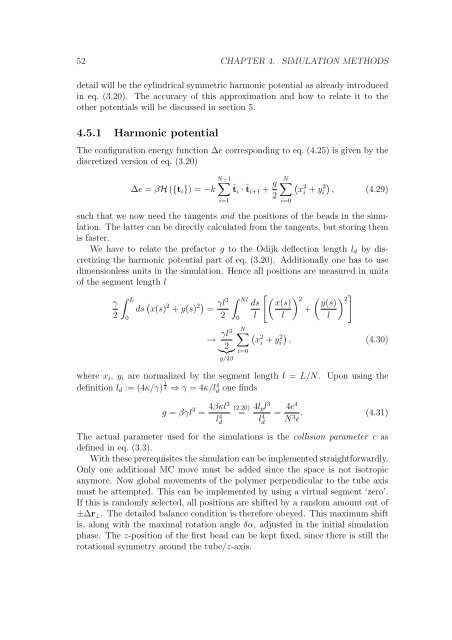Polymers in Confined Geometry.pdf
Polymers in Confined Geometry.pdf
Polymers in Confined Geometry.pdf
You also want an ePaper? Increase the reach of your titles
YUMPU automatically turns print PDFs into web optimized ePapers that Google loves.
52 CHAPTER 4. SIMULATION METHODS<br />
detail will be the cyl<strong>in</strong>drical symmetric harmonic potential as already <strong>in</strong>troduced<br />
<strong>in</strong> eq. (3.20). The accuracy of this approximation and how to relate it to the<br />
other potentials will be discussed <strong>in</strong> section 5.<br />
4.5.1 Harmonic potential<br />
The configuration energy function ∆e correspond<strong>in</strong>g to eq. (4.25) is given by the<br />
discretized version of eq. (3.20)<br />
N−1 <br />
∆e = βH ({ti}) = −k ˆti · ˆti+1 + g<br />
2<br />
i=1<br />
N 2<br />
xi + y 2 i , (4.29)<br />
such that we now need the tangents and the positions of the beads <strong>in</strong> the simulation.<br />
The latter can be directly calculated from the tangents, but stor<strong>in</strong>g them<br />
is faster.<br />
We have to relate the prefactor g to the Odijk deflection length ld by discretiz<strong>in</strong>g<br />
the harmonic potential part of eq. (3.20). Additionally one has to use<br />
dimensionless units <strong>in</strong> the simulation. Hence all positions are measured <strong>in</strong> units<br />
of the segment length l<br />
γ<br />
2<br />
L<br />
0<br />
ds x(s) 2 + y(s) 2 = γl3<br />
2<br />
→ γl3<br />
2<br />
<br />
g/2β<br />
Nl<br />
0<br />
ds<br />
l<br />
i=0<br />
x(s)<br />
l<br />
2<br />
<br />
2<br />
y(s)<br />
+<br />
l<br />
N 2<br />
xi + y 2 i , (4.30)<br />
where xi, yi are normalized by the segment length l = L/N. Upon us<strong>in</strong>g the<br />
one f<strong>in</strong>ds<br />
def<strong>in</strong>ition ld := (4κ/γ) 1<br />
4 ⇒ γ = 4κ/l 4 d<br />
g = βγl 3 = 4βκl3<br />
l 4 d<br />
i=0<br />
(2.20)<br />
= 4lpl 3<br />
l 4 d<br />
= 4c4<br />
N 3 . (4.31)<br />
ɛ<br />
The actual parameter used for the simulations is the collision parameter c as<br />
def<strong>in</strong>ed <strong>in</strong> eq. (3.3).<br />
With these prerequisites the simulation can be implemented straightforwardly.<br />
Only one additional MC move must be added s<strong>in</strong>ce the space is not isotropic<br />
anymore. Now global movements of the polymer perpendicular to the tube axis<br />
must be attempted. This can be implemented by us<strong>in</strong>g a virtual segment ‘zero’.<br />
If this is randomly selected, all positions are shifted by a random amount out of<br />
±∆r⊥. The detailed balance condition is therefore obeyed. This maximum shift<br />
is, along with the maximal rotation angle δα, adjusted <strong>in</strong> the <strong>in</strong>itial simulation<br />
phase. The z-position of the first bead can be kept fixed, s<strong>in</strong>ce there is still the<br />
rotational symmetry around the tube/z-axis.













